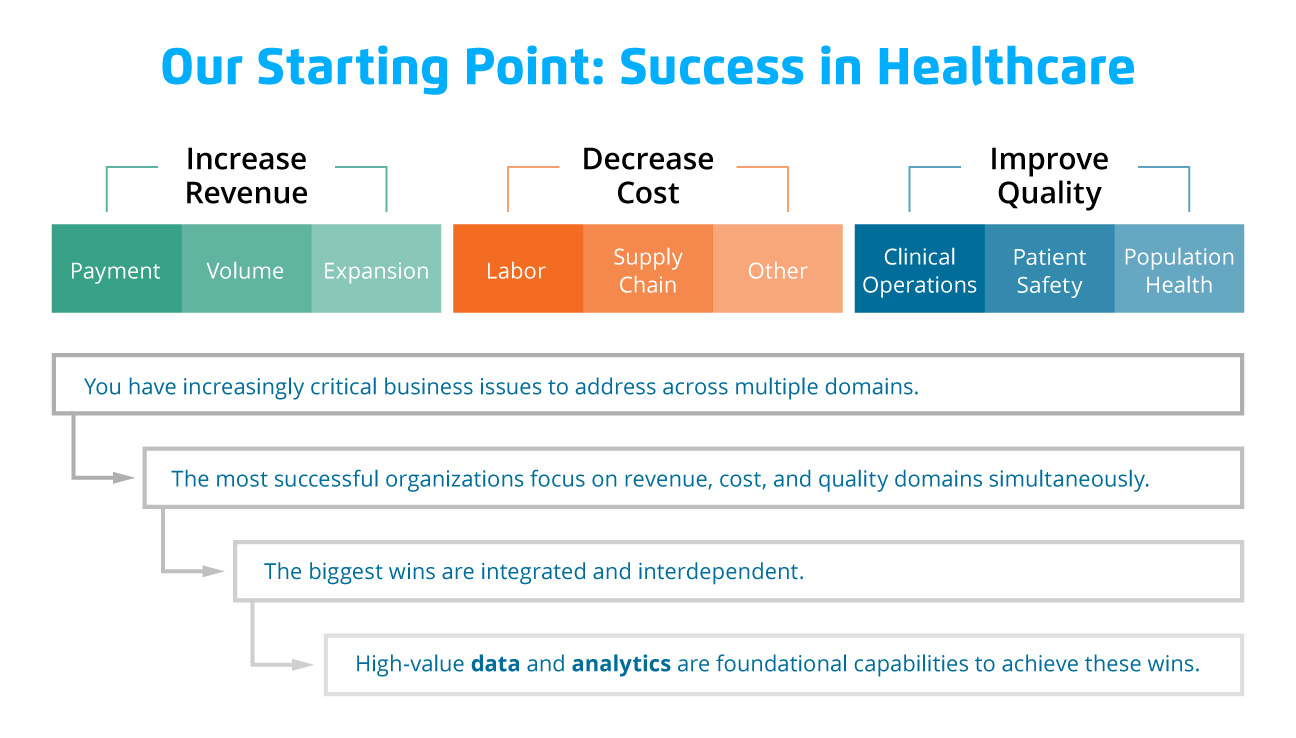A low-resolution photograph doesn’t show much detail about the image’s subjects and environment. Viewers can only guess about the scene or individuals they’re observing—are they familiar faces, happy or sad, or is there something usual in the background? Low-quality healthcare data and analytics works like a subpar photo. Users can see the most basic characteristics of a patient or trend but not enough detail to make informed decisions. For example, does a patient have comorbidities putting them at greater risk, or is a facility trending towards an increase in sepsis? For better view, high-quality data and analytics bring patients and health system operations into focus, showing a clear, comprehensive picture from the patient to facility level.

The simple truth in a complex healthcare landscape is that better data and analytics gives decision makers a clearer picture of their environment. Just as a higher-resolution photograph shows greater detail and brings background images into focus, high-value data and analytics clarifies information, helping healthcare leaders recognize looming threats and improvement opportunities while they have time to act.
High-value data and analytics reflects the use of many domains (e.g., clinical, revenue, cost, inpatient, and ambulatory, etc.) to create a comprehensive picture of an organization’s well-being. Healthcare leaders can optimize the value of their analytics investment, or bring more details into focus, when they have the ability and infrastructure to integrate their high-value data and analytic assets into every decision seamlessly, repeatedly, and automatically.
Healthcare leaders aiming to power better decisions across the enterprise start to optimize their data and analytics investments by considering a beginning healthcare success framework (Figure 1) and identifying opportunities and roadblocks to progress.

As Figure 1 shows, a data- and analytics-powered healthcare business framework includes three drivers of opportunities: revenue, cost, and quality. The framework ensures organizations always have these three areas in focus, enabling them to identify high-value opportunities and associated challenges. With these domains interconnected across the enterprise, addressing them simultaneously is critical to identifying new avenues of success. Seeing each domain and challenge together in detail—in high resolution—demands high-value data and analytics to enable sharp focus on all barriers to success.
High-value data and analytics are requisite capabilities for multidomain healthcare success, as they put critical insights in focus in a complex, crowded information landscape:
After its people (i.e., delivery teams), high-value data is a healthcare organization’s most mission-critical asset for success. This class of data requires ingesting and processing a growing volume of sources to support revenue, cost, and quality use cases and ensuring data is integrated, reusable, expert informed, and transparent.
An organization integrates high-value analytics into standard, easy-to-use analytic and business intelligence tools. High-value analytics are essential to enabling augmented answers to a broader set of business-critical issues and optimizing the analytic capabilities across the organization. This disseminating of analytics is known as productized artificial intelligence (AI).
While high-value data and analytics are critical, putting any asset to work in favor of business goals require technology—in this case, a modern data and analytics platform. A modern, enterprisewide data and analytics platform (e.g., the Health Catalyst Data Operating System (DOS™)) is foundational to data and analytic success and productized AI.
A winning platform will be the following:
A modern data and analytics platform with the above attributes will substantially scale an organization’s analytics productivity, setting the stage for healthcare leaders to view their data engines as “data factories” that continuously develops comprehensive, clear images of the organization’s status.
A data-factory mentality evokes images of efficiency, scalability, quality. Like an industrial factory, the data factory performs operations, logistics, and processing—in this case to develop consistent, reliable, high-resolution views of organizational data:
Data factory processes start with data ops, which integrates high-resolution data quality in each step of the production process. Data ops use tools adopted from modern data engineering, including version control and deployment processes, with ongoing monitoring to react to changes that impact the data product.
Data orchestration performs like a logistics system in a factory. Modern platform data orchestration capabilities ensure raw data image, or materials, to go to the right place, in the right order, at the right time in an efficient and automated process.
Data processing comprises acquiring the raw data materials, processing them, and refining them into the final product—a high-resolution, or detailed, view of the data. Process tools can include bulk or streaming data ingestion tools, highly scalable databases, and advanced analytics tools that enable machine learning and natural language processing to refine to final data product.
The data-factory perspective overrides the common request-based approach to the data engine, in which data teams produce reports when requested, overwhelming the system, and delaying data for decision makers. Instead, the factory produces high-quality data and analytics efficiently, enabling self service and empowering team members with reusable data and analytics to drive decisions.
Low-quality data and analytics are like a low-resolution photo that doesn’t depict all images clearly—information might exist about an emerging problem (e.g., potential patient safety events or operational or financial problems), but subpar data and analytics blurs the early warning signs; once threats are close enough to detect, decision makers often don’t have time to make real-time (less retrospective) risk mitigation. In healthcare data and analytics, progressing from that blurry, low-resolution image to the crisp, high-resolution alternative requires high-value data and analytics and a modern platform, all operationalized with a data-factory mentality for efficiency, scalability, quality.
Would you like to learn more about this topic? Here are some articles we suggest: